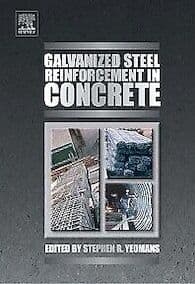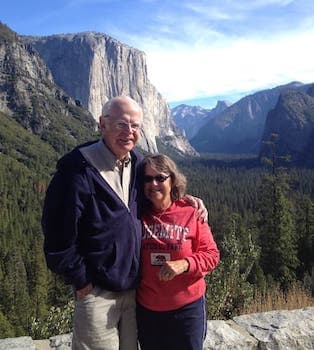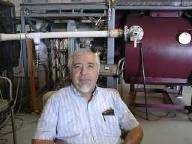
Home of the world famous 'finishing.com HOTLINE' since 1989
-----
Aluminum posts embedded in concrete corrosion problems
Aluminum should not be embedded in concrete. The alkalinity of concrete corrodes the aluminum, and the aluminum ions dissolving in the concrete cause spalling. Consult the codes.
For casual and homeowner projects where you're going to do it anyway, coating the aluminum with an appropriate bitumen product, and/or using a plasticized or epoxy setting compound are the minimal approach.
Next time you stay in a hotel/motel with a balcony, look at the railing. What you'll probably see is an aluminum base on top of the concrete, with a polymer gasket in between, and stainless steel anchor bolts.
by Stephen Yeomans

on eBay or Amazon
or AbeBooks
(affil link)
Q. I have read all the warnings on not to install aluminum posts with concrete. I may have found a solution and wanted to know if it will work properly without any of the issues that commonly occur with concrete and aluminum installs. It is expensive compared to concrete.
My project is core drilling 4"dia holes in 5" thick walkway 10" in from the edge, placing 2"x 2" sq. aluminum posts ctr. I came across a product called VITROBOND post setting compound mfg by Atlas Minerals & Chemicals. It is a plasticized hot-pour silica filled sulfur based mortar, it must be heated to 275 deg. to pour, sets up immediately, twice as strong as concrete. Any thoughts on using this product with aluminum?
Thank you
Property Maintenance - New Jersey
April 30, 2025
A. Hi Bill,
I don't think studying corrosion charts and theorizing is the right answer here. Considering the huge potential market, surely Atlas and its competitors have conducted corrosion testing on aluminum and know whether this application will work well or not.
One alternative, which might be cheaper and easier, or might not, would be chromate conversion coating, followed by a careful bitumen coating on the aluminum tubes. A second alternative, which seems to be the standard approach, is to avoid embedding, and use stainless steel anchor bolts in the concrete, and an elastomeric gasket between the concrete and an aluminum base plate.
Luck & Regards,

Ted Mooney, P.E. RET
Striving to live Aloha
finishing.com - Pine Beach, New Jersey
Ted is available for instant help
or longer-term assistance.
![]() Ted,
Ted,
Thank you for taking the time to answer my question.
Bill
- New Jersey
May 13, 2025
Multiple threads merged: please forgive chronology errors and repetition 🙂
Q. We have, what appears to be, a corrosion problem occurring on coated Aluminum handrail post, that are embedded approximated 2-1/2" to 3" into the top a 8" wide poured concrete knee wall. The corrosion has expanded to the point that it has caused the concrete to spall from the wall; some chunks 2-3" thick x 10-12" long. The fracture occurs at the posts and emanates outwards at a (±) 30-degree angle. The posts are 1.8" x 1.8" (snap together type) Aluminum alloy 6063-FHS-T6 (possibly manufactured by Easco Aluminum). The setting cement is Bonsal Commercial Anchor Cement, "a polymer modified shrinkage compensating hydraulic cement-based product", which according to Bonsal "has been formulated not to contribute to the corrosion of Aluminum". The Aluminum posts are coated with "Morton Poyceram 1400 as its standard finish. This finish is a baked polyester enamel coating which is manufactured to meet or exceed AAMA specification 603.8". There is no sealant at the base of the post, where it meets the Bonsal grout. Water most likely settles between the post and the setting cement. The project is approximately two miles from the Gulf of Mexico. Salt spray is probably the corrosive agent, but how is it penetrating the coating? There are nearly 700 posts in question. We have removed the spalled concrete and examined the posts. The coating has become a white powder and has separated from the post and is attached to the grout. The posts are pitted at the corroded areas.
This a safety issue. The spalled concrete may fall from the 8th floor; and corroded rails may not be adequate in the future. We have more hi-rises under construction and want to eliminate it before it is incorporated into the next building Thanks. Any help and advice will be appreciated.
Ed JohnsonDirector of Construction, General Contractor - Fort Myers, Florida, USA
2003
A. The polymeric coatings will never protect your posts, as they are largely barrier coatings. You need a sacrificial coating beneath the polymer, such as cadmium or pure aluminum, protected further with a chromate conversion coating. As cadmium is a carcinogen, I would suggest you consider IVD aluminum. You can find a number of companies that can do the coating and chromate conversion work for you on this website.

Jim Treglio - scwineryreview.com
PVD Consultant & Wine Lover
San Diego, California
A. As a structural engineer, I recommend you not use aluminum in contact with concrete, the white powder might be aluminum hydroxide (I got this from a web site --
members.aol.com/chrushstone/cor_aclz.htm ⇩), which is what is degrading the concrete by causing expansion underneath the railing/concrete connection and causing the concrete to eventually burst and spall. This corrosion is exacerbated by the presence of sodium chloride (salt) blown in from the ocean.
Stainless steel is routinely used in water and waste water treatment plants to prevent an aluminum reactivity issue when embedded into concrete.
The problem with the railing is a life-safety issue possibly involving someone falling to their death after leaning on the railing. There is also the possibility of passersby below being killed by falling chunks of concrete if they are large enough and fall from a large enough height. It is also possible, depending on how the concrete is designed to support the balcony that the spalling is destroying the concrete's load bearing capacity and leading to an eventual collapse.
You should have a structural engineer or a forensic testing company take a look at the situation.
- Minneapolis, Minnesota
2005
Ed. update: Sorry, that link is now broken.
Multiple threads merged: please forgive chronology errors and repetition 🙂
Multi-color anodized aluminum artwork on a bridge
Q. I am a public artist with a commission to do a design on a bridge. The bridge walls are 3' high by 71 ft. long (2 walls)- this is the concrete part. My design will be on both (inner) sides of the concrete. Need thoughts about how an anodized aluminum low-relief design in blues, green and soft yellows would work re: duration (60 years is requested durability!), etc.
Thanks,
Lucy Blakeartist - Los Angeles, California, USA
2004
A. 60 years is a very tall order for dyed anodizing. Exposure to sunlight (and maybe saltwater, not sure what the bridge is over) would eventually cause fading. I'm not aware of any coating that's "guaranteed" for 60 years.

Marc Green
anodizer - Boise, Idaho
A. Hi Lucy. Mark is correct that 60 years is a very tall order for any finish. Further, aluminum dyes will not hold up outside for too many years, and runoff of water from the concrete onto the aluminum (unless your design can somehow preclude that) would be a corrosion staining issue. Anodized and dyed aluminum mounted or embedded on a concrete bridge is probably going to be quite unsatisfactory as artwork.
I have seen pics of some of your fabulous public projects and am confident that you can dazzle us with a better suited material like ceramic tile or stainless steel or Kynar paint!
Luck & Regards,

Ted Mooney, P.E.
Striving to live Aloha
finishing.com - Pine Beach, New Jersey
Ted is available for instant help
or longer-term assistance.
Multiple threads merged: please forgive chronology errors and repetition 🙂
Q. I had an open sided carport type roof installed over my deck. One end is attached to my roof overhang the other end is 17 feet away my house with 3 oven baked painted hollow aluminum post.
They are about 3 inches sq. The contractor put these aluminum post 42" in the ground and then poured concrete in the holes up to 3 or 4" below ground level, the holes were about 8" in diameter -- maybe 10". When my neighbor a retired structural engineer came over to look at the job he told me that you never put aluminum in concrete, especially exposed to the weather outside and the concrete meets the aluminum a few inches below ground level. He said it will it will not last very long. Is this true? If so could someone direct me to a book or specification manual, etc. that I could go to that would back this up. They would probably want to see something official before they would correct the problem. The local building inspector said there is nothing in the local code on the subject so he can't help me unless I get something official that deals with this and he might be able to help.
Thank You,
Ronald D. Buryconsumer - Flint, Michigan, USA
2005
Q. Hello Ronald - did you ever receive an answer to your question regarding aluminum buried in concrete? Thanks,
Larry Theml- San Diego, California, USA
2006
A. I am a Registered Special Inspector ICC WABO ACI Level I. The code does not allow embedded aluminum in concrete due to electrolytic action. The concrete expands & falls apart around the aluminum, & the aluminum thins to nothing as it gives up anions.
Brian RobertsonSeattle, Washington
2006
Multiple threads merged: please forgive chronology errors and repetition 🙂
Concrete filling of aluminum columns
Q. I would like to fill a 2 x 6 hollow aluminum column with concrete for strength. I know concrete reacts with aluminum. How do I protect the aluminum from the concrete? I know that a tar based product will work but how many mils thick must it be or is this even the best product?
Michael P. McIntyreconstruction contractor - Orlando, Florida, USA
2006
Q. I have lacrosse goals made of aluminized metal in the form of 1-1/2" pipes. In order to make them stronger and keep them from bending and breaking, I wanted to fill the bottom portions of the pipes with cement. Will the lime from the cement eat and destroy the metal or just turn the inside of the pipes black?
Joseph Gephart- West Palm Beach, Florida
2006
A. Hi, Joseph. Although the word 'aluminized' may have a more general meaning to some people, to readers on this finishing website it has the very specific meaning that the pipes are steel which has been hot dipped in molten aluminum to produce a sacrificial aluminum coating on the steel.
Assuming these are indeed steel pipes, I don't think the attack of the concrete on the aluminum coating inside them will be a significant problem for a non-critical application like a goal post. But it is frowned upon, and certainly would be no good for a nuclear power plant :-)
If you mean that the pipes are made of aluminum, I would not do it. Good luck!
Regards,

Ted Mooney, P.E.
Striving to live Aloha
finishing.com - Pine Beach, New Jersey
Ted is available for instant help
or longer-term assistance.
Q. Does anyone know if there is a type of concrete or grout or mortar mix that would not cause any corrosion or chemical reaction to occur? In addition to that, would it have the same strength characteristics (i.e. 2500 psi)?
Brian Hall- Orlando, Florida, USA
2006
A. There is a material sold for repairing divots in concrete that would probably fit your need. Some have a good bit of epoxy and others have a huge amount of latex. Actually, it is probably stronger, but it is quite a bit more expensive.
James Watts- Navarre, Florida
Q. What compound can be safely used to "re-anchor" loose aluminum railing? Thanks!
Robin Dreggors- St. Simons Island Georgia USA
July 2, 2009
A. Hi, Robin. Although I can't speak from my own experience or my own knowledge of the codes, I think the previous responses are suggesting that the problem is not solvable, i.e., that you cannot safely embed aluminum in concrete.
When I see aluminum railings, it seems they are always bolted down with stainless steel anchor bolts, and an elastomer gasket/pad between the concrete and the aluminum.
Regards,

Ted Mooney, P.E.
Striving to live Aloha
finishing.com - Pine Beach, New Jersey
Ted is available for instant help
or longer-term assistance.
Q. Is there any corrosion or rusting of metal when bolting a foot railings of a metal gazebo directly to the cement? If there is, what can be used to separate the two components?
Lee Maessen- Canada
May 20, 2012
A. Hi Lee.
It might depend a bit on whether the gazebo feet are aluminum or steel, and what surface treatment they have received, but I don't see a serious problem. What will cause rapid rust, though, is if water is retained between the foot and the concrete. Make sure this isn't a low spot, and is preferably a high spot. Good luck.
Regards,

Ted Mooney, P.E.
Striving to live Aloha
finishing.com - Pine Beach, New Jersey
Ted is available for instant help
or longer-term assistance.
Q. Dear Sirs: I am involved in the design of 6005-T5 aluminum parts that get embedded in concrete. Is Alodine finish a suitable anti-corrosive barrier for the aluminum parts for this condition? Can you direct me to a site with the Alodine on aluminum anti-corrosive properties? Thank you. Steve.
Steve Gernes- New Brighton, Minnesota, USA
February 13, 2017
A. Hi Steve. Alodine is a Henkel Corporation trade name for their line of chromate conversion coatings for aluminum.
Hopefully they can give you specifics; otherwise search for "chromate conversion coating of aluminum", "chem-film" (a term used mainly in the USA), or MIL-DTL-5541 [⇦ this spec on DLA]. But we do have postings above which indicate aluminum should not be imbedded in concrete. As a minimum the posts should be both Alodined and coated with a bitumen product, but even this would probably only be appropriate for casual applications rather than serious construction projects.
Regards,

Ted Mooney, P.E. RET
Striving to live Aloha
finishing.com - Pine Beach, New Jersey
Ted is available for instant help
or longer-term assistance.
No dead threads!
Your Q, A, or Comment puts this thread on The Finishing.com HOTLINE.
